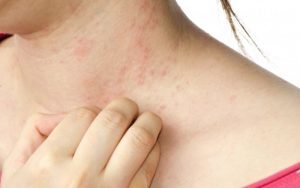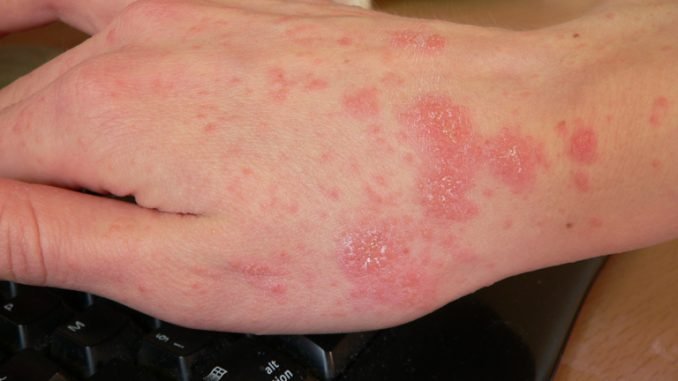Summary
Scabies is a skin condition that causes intense itching and a rash. It is caused by mites known as Sarcoptes scabiei, which can only be seen under a microscope. The name “scabies” is derived from the Latin word scabiēs, meaning “itch.”
A person develops scabies when these mites spread across the skin, burrow into the layers beneath, and lay eggs. This process allows the mites to survive and reproduce. The itching experienced is an allergic reaction of the body to the mites, their eggs, and their waste products.
Common symptoms of scabies include severe itching, especially at night, a pimple-like rash, sores from scratching, and the presence of tiny blisters and bumps on the skin.
Currently, scabies is treated with prescribed medications that contain chemicals designed to kill the mites and their eggs. These treatments are effective in eliminating the infestation and alleviating the associated symptoms.
Understanding scabies and its transmission is essential for effective prevention and treatment. If you suspect you have scabies, it is important to consult a healthcare professional for appropriate diagnosis and management.
Table of Contents
Symptoms of Scabies

Scabies can affect an individual multiple times. During the first infestation, symptoms may appear between two to six weeks after exposure. In subsequent infestations, symptoms tend to develop more rapidly due to a quicker immune response.
The symptoms of scabies include the following:
- Itching. Intense itching is the most common symptom of scabies, often becoming worse at night. This persistent itching is caused by the body’s allergic reaction to the mites, their eggs, and their waste products.
- Rash. The scabies rash results from the mites burrowing into the skin, creating small tunnels that appear as thin, irregular lines. These tunnels can cause raised, red bumps that resemble pimples. In some cases, fluid-filled blisters may form, leading to secondary bacterial infections if scratched excessively.
- Sores. Due to relentless scratching, the affected areas of the skin can develop sores. These open sores increase the risk of bacterial infections, which may cause additional redness, swelling, and pain.
- Thickened Skin (Crusting). In severe cases of scabies, thousands of mites can infest the skin, leading to thickened, crusted skin known as Norwegian scabies. The crusts may appear gray and can crack, making it difficult to treat the infestation effectively.
Recognizing these symptoms early is essential for prompt treatment and to prevent the spread of scabies to others. If you experience persistent itching, especially at night, and notice a rash with burrows or sores, it is important to consult a healthcare professional for accurate diagnosis and appropriate treatment.
Types of Scabies
Scabies is caused by a single type of mite, Sarcoptes scabiei. However, this mite can lead to various forms of scabies, each presenting with distinct symptoms and levels of severity:
- Common Scabies. This is the most prevalent form of scabies. It causes intense itching accompanied by a rash, typically appearing on the hands, wrists, and other parts of the body. Unlike other forms, common scabies does not affect the face or scalp, making these areas usually clear of symptoms.
- Nodular Scabies. This form results in the development of itchy nodules on the skin, particularly in the genital area, groin, and underarms. These nodules are small, raised bumps that can cause significant discomfort and are often more persistent than the rash seen in common scabies.
- Norwegian Scabies. Also known as crusted scabies, this is a severe and highly contagious form of scabies. It leads to the formation of thick crusts or scales on the skin, primarily due to an overwhelming infestation of mites and their eggs beneath the skin’s surface. Norwegian scabies is especially common in individuals with weakened immune systems, such as those with HIV/AIDS or those undergoing chemotherapy, making it more challenging to treat and control.
Understanding the different types of scabies is essential for proper diagnosis and treatment. While common and nodular scabies can often be managed with topical treatments, Norwegian scabies may require more intensive medical intervention to eliminate the severe infestation and prevent its spread.
Diagnostic Procedures for Scabies
Diagnosing scabies involves a combination of physical examinations and specific tests to confirm the presence of mites. Accurate diagnosis is essential for effective treatment and to prevent the spread of scabies to others.
- Physical Examination. A healthcare professional will inspect the skin for characteristic signs of scabies, such as burrows, rashes, and areas of intense itching. Common sites for scabies infestation include the wrists, elbows, armpits, waist, and genital area. The presence of these signs, especially in multiple areas of the body, strongly suggests scabies.
- Skin Scraping. A small sample of skin is taken from the affected area using a scalpel or blade. This sample is then placed on a microscope slide and examined for the presence of mites, eggs, or fecal matter. Identifying these elements under the microscope confirms the diagnosis of scabies.
- Potassium Hydroxide (KOH) Test. The skin scraping is treated with a potassium hydroxide solution, which dissolves the skin cells but leaves the mites and their eggs intact. This makes it easier to visualize the mites under a microscope, enhancing the accuracy of the diagnosis.
- Dermatoscopy. A dermatoscope, which is a handheld magnifying device with a light source, may be used to examine the skin more closely. This non-invasive method allows healthcare professionals to see the burrows and mites directly on the skin, aiding in a quicker diagnosis without the need for skin scrapings.
- Biopsy. In rare cases where the diagnosis is unclear or other skin conditions are suspected, a skin biopsy may be performed. This involves taking a small sample of skin tissue for laboratory analysis to rule out other dermatological disorders that mimic scabies.
- Fungal Culture. Although scabies is caused by mites, secondary fungal infections can occur due to excessive scratching and skin damage. If a fungal infection is suspected, a fungal culture may be conducted using skin samples to identify the specific type of fungus involved.
Early and accurate diagnosis of scabies is crucial for initiating appropriate treatment and preventing further transmission. If you experience persistent itching, especially at night, and notice a rash with burrows or sores, it is important to consult a healthcare professional for proper evaluation and management.
Complications of Untreated Scabies
If scabies is left untreated, the infestation can lead to several complications that may affect both physical and emotional well-being. Prompt and effective treatment is essential to prevent these potential issues.
- Secondary Bacterial Infections. Persistent scratching due to intense itching can break the skin, allowing bacteria such as Staphylococcus aureus or Streptococcus pyogenes to enter and cause infections like cellulitis or impetigo. These infections can result in increased redness, swelling, pain, and may require antibiotic treatment.
- Crusted Scabies (Norwegian Scabies). In severe cases, especially among individuals with weakened immune systems, scabies can develop into crusted scabies. This form is characterized by thick, crusted skin lesions containing large numbers of mites and eggs. Crusted scabies is highly contagious and more difficult to treat, often requiring intensive medical intervention.
- Chronic Itching and Discomfort. Ongoing scabies infestations can lead to persistent itching and discomfort, significantly impacting daily activities and quality of life. The constant urge to scratch can also lead to sleep disturbances and reduced productivity.
- Emotional and Psychological Impact. Dealing with scabies can cause emotional distress, embarrassment, and anxiety, particularly if the condition spreads to others or leads to visible skin lesions. The stigma associated with scabies may affect an individual’s social interactions and mental health.
- Spread to Others. Without proper treatment, scabies can easily spread to family members, friends, and others through close personal contact or sharing of contaminated items. This not only affects the individual but also poses a public health concern, requiring widespread treatment to control outbreaks.
- Increased Severity in Immunocompromised Individuals. People with weakened immune systems, such as those with HIV/AIDS, cancer patients undergoing chemotherapy, or individuals on immunosuppressive medications, are more susceptible to severe scabies infestations. Their bodies may struggle to control mite populations, leading to more extensive skin involvement and complications.
Preventing and treating scabies promptly is crucial to avoid these complications. If you suspect you have scabies, consult a healthcare professional for appropriate diagnosis and treatment to ensure effective management and reduce the risk of complications.
Causes of Scabies

Scabies is a highly contagious skin condition caused by the mite Sarcoptes scabiei var. hominis. These microscopic mites require human hosts to survive and reproduce. One of the primary indicators of scabies is intense itching accompanied by a rash, which results from the mites burrowing into the skin to lay their eggs. This burrowing activity triggers an allergic reaction in the body, leading to severe itching and inflammation.
The direct cause of scabies is the infestation of the Sarcoptes scabiei mites on the skin. Under normal circumstances, these mites coexist harmlessly with other microorganisms on the skin. However, certain conditions can disrupt this balance, allowing the mites to multiply excessively and cause an infestation. Factors such as oily skin, hot or humid climates, weakened immune systems, and hormonal changes can create an environment conducive to the rapid growth of these mites.
Transmission Vectors
Scabies mites are easily transmitted from person to person through direct skin-to-skin contact. Additionally, the mites can spread indirectly by coming into contact with contaminated items. Common vectors for mite transmission include:
- Household Items. Mites can survive on surfaces such as furniture, carpets, and other household items, making it possible to contract scabies by touching these contaminated objects.
- Clothing. Sharing or wearing clothing, especially tight-fitting garments, can facilitate the transfer of mites from one person to another.
- Bedding. Mites can inhabit sheets, blankets, and pillows. Using or sharing these items with an infected person increases the risk of transmission.
- Confinements. Enclosed environments like prisons and detention centers are conducive to the spread of scabies due to close living quarters and frequent skin contact among individuals.
- Rehabilitation Facilities. Places where individuals reside and receive care, such as rehab centers, can be hotspots for scabies outbreaks if proper hygiene measures are not maintained.
- Nursing Homes. Elderly populations in nursing homes are particularly vulnerable to scabies due to factors like weakened immune systems and close living conditions.
- Schools. Scabies can spread rapidly in school settings where children are in close contact during activities and play.
- Gym Locker Rooms. Shared gym equipment, lockers, and communal showers provide ideal environments for mites to thrive and spread.
Understanding these transmission vectors is crucial for preventing scabies outbreaks. Practicing good personal hygiene, avoiding the sharing of personal items, and maintaining clean living environments are key steps in controlling the spread of scabies.
Prevention of Scabies

Preventing scabies can be challenging due to its highly contagious nature. However, the following measures can significantly reduce the risk of contracting and spreading this skin condition:
- Proper Washing and Drying of Clothing and Bedding. Wash clothes, towels, and bedding thoroughly, preferably in warm water, to kill any mites present. Ensure these items are thoroughly dried under direct sunlight, as heat helps eliminate mites. For items that cannot be washed, store them in sealed plastic bags for at least three weeks to deprive the mites of food, leading to their death.
- Regular Vacuuming of Living Spaces. Vacuum carpets and upholstered furniture regularly to remove any mites and their eggs. It is also important to clean the vacuum cleaner itself, including the bag or container, to prevent mites from surviving and spreading.
By incorporating these preventive measures into your daily routine, you can significantly lower the chances of developing scabies. Maintaining a clean living environment, practicing good personal hygiene, and avoiding the sharing of personal items are key strategies in controlling the spread of scabies infestations.
Risk Factors for Scabies
Scabies can affect anyone, regardless of how clean they are. However, certain habits and living conditions can significantly increase the risk of contracting this highly contagious skin condition. Understanding these risk factors is essential for prevention and early intervention.
- Living in Close-Knit Environments. Staying in places where people are in close proximity to one another greatly increases the likelihood of scabies transmission. Individuals residing in the following settings are more susceptible:
- Dormitories. Shared living spaces and communal facilities facilitate the spread of scabies among residents.
- Prisons. Overcrowded conditions and limited access to personal hygiene resources make scabies outbreaks more common.
- Rehabilitation Centers. Close living quarters and frequent physical contact among individuals in rehab facilities heighten the risk of scabies infestation.
- Daycare Centers. Children are particularly vulnerable to scabies due to their close interactions and tendency to share toys and personal items, making daycare centers common hotspots for transmission.
- Nursing Homes. Elderly residents often have weakened immune systems, making them more prone to severe forms of scabies, such as Norwegian scabies.
- Age-Related Factors. Scabies is more prevalent among certain age groups:
- Young Children. Children are more likely to contract scabies due to their developing immune systems and frequent close contact in group settings like schools and daycare centers.
- Elderly Individuals. Older adults, especially those with compromised immune systems, are at higher risk for severe scabies infestations.
- Socioeconomic Factors. A study conducted in 2009 in a low-income area in Brazil identified additional risk factors that contribute to the prevalence of scabies:
- Poor Housing Conditions. Overcrowded and unsanitary living environments provide ideal conditions for the spread of scabies mites.
- Lack of Education. Limited awareness about proper hygiene practices can lead to inadequate prevention measures.
- Low Family Income. Economic constraints may limit access to healthcare and proper sanitation facilities, increasing the risk of scabies infestation.
- Large Household Size. Families with many children or members living together increase the chances of mite transmission within the household.
- Sharing Personal Items. Using or lending clothing, towels, and bedding from infected individuals can facilitate the spread of scabies mites.
- Infrequent Bathing. Not bathing regularly allows mites to thrive on the skin, increasing the risk of infestation.
- Immune System Status. Individuals with weakened immune systems are more susceptible to scabies:
- People with Chronic Illnesses. Conditions such as HIV/AIDS or those undergoing chemotherapy can compromise the immune system, making it harder to fight off scabies mites.
- Elderly Individuals. Age-related decline in immune function increases vulnerability to scabies infestations.
By recognizing and addressing these risk factors, individuals can take proactive steps to reduce their chances of developing scabies. Maintaining good personal hygiene, avoiding the sharing of personal items, and ensuring clean living environments are key strategies in preventing scabies infestations.
Scabies FAQs
Here are the top 10 frequently asked questions about scabies, along with detailed answers to help you understand this common skin condition.
- What is scabies?
Scabies is a highly contagious skin condition caused by the mite Sarcoptes scabiei var. hominis. These microscopic mites burrow into the upper layer of the skin to live and lay eggs, leading to intense itching and a pimple-like rash. The body’s allergic reaction to the mites, their eggs, and their waste products results in the severe itching and inflammation characteristic of scabies. - How is scabies transmitted?
Scabies is primarily transmitted through direct, prolonged skin-to-skin contact with an infected person. It can also spread indirectly by sharing personal items such as clothing, towels, bedding, and furniture that have been contaminated with mites. Public places like swimming pools, gyms, and communal living environments can facilitate the spread of scabies due to the close contact and shared surfaces. - What are the common symptoms of scabies?
Common symptoms of scabies include:- Intense Itching. Especially severe at night, this itching is the most prominent symptom.
- Pimple-Like Rash. Small red bumps and blisters may appear on the skin.
- Burrow Tracks. Thin, irregular lines on the skin where mites have burrowed, often found between the fingers, wrists, elbows, armpits, waist, buttocks, and genital area.
- Sores. Caused by scratching, these sores can become infected with bacteria, leading to increased redness, swelling, and pain.
- Thickened, Crusted Skin (Norwegian Scabies). In severe cases, especially in individuals with weakened immune systems, the skin can become thickened and crusted with scales containing thousands of mites.
- Who is at risk of developing scabies?
Anyone can develop scabies, but certain factors increase the risk:- Living in Close-Knit Environments. Places like dormitories, prisons, nursing homes, and daycare centers facilitate the spread of scabies.
- Age. Scabies is more common in children and the elderly.
- Weakened Immune System. Individuals with compromised immune systems, such as those with HIV/AIDS or undergoing chemotherapy, are more susceptible to severe forms of scabies.
- Poor Hygiene. While scabies is not caused by poor hygiene, inadequate skin care can increase vulnerability to infestation.
- How is scabies diagnosed?
Diagnosis of scabies typically involves:- Physical Examination. A healthcare professional will look for characteristic burrows, rash, and areas of intense itching.
- Skin Scraping. A small sample of skin is taken from the affected area and examined under a microscope to identify mites, eggs, or fecal matter.
- Dermatoscopy. A special magnifying tool may be used to visualize mites and burrows on the skin.
- Biopsy. In rare cases, a skin biopsy may be performed to rule out other skin conditions.
- How is scabies treated?
Treatment for scabies aims to eliminate the mites and alleviate symptoms:- Topical Medications. Prescribed creams and lotions containing permethrin (5%) or benzyl benzoate are applied to the entire body from the neck down and left on for several hours before washing off.
- Oral Medications. In severe cases or for those who cannot tolerate topical treatments, oral ivermectin may be prescribed.
- Antihistamines. To relieve itching, antihistamine medications can be used alongside antifungal treatments.
- Cleaning and Disinfecting. All clothing, bedding, and personal items used by the infected person should be washed in hot water and dried on a high heat setting. Items that cannot be washed should be sealed in plastic bags for at least 72 hours to kill any remaining mites.
- Can scabies be cured?
Yes, scabies can be effectively treated and cured with appropriate medications. However, it is crucial to follow the treatment regimen thoroughly and treat all close contacts simultaneously to prevent reinfestation and further spread of the mites. - Is scabies contagious to pets?
Scabies mites specific to humans (Sarcoptes scabiei var. hominis) do not infest pets. However, animals like dogs can be affected by a different variety of scabies mites (Sarcoptes scabiei var. canis). If a pet shows signs of skin irritation, it is important to consult a veterinarian for appropriate treatment. - Can scabies recur after treatment?
Yes, scabies can recur if the treatment is not completed properly or if there is re-exposure to contaminated environments or individuals. Ensuring that all household members and close contacts are treated simultaneously and maintaining clean living conditions can help prevent recurrence. Additionally, adhering to preventive measures such as avoiding sharing personal items and practicing good hygiene can reduce the risk of reinfestation. - What should I do if I suspect I have scabies?
If you suspect you have scabies, it is important to:- Consult a Healthcare Professional. Seek medical advice for an accurate diagnosis and appropriate treatment plan.
- Follow Treatment Instructions Carefully. Apply prescribed medications as directed and complete the entire treatment course.
- Inform Close Contacts. Notify household members and close contacts so they can be treated simultaneously to prevent the spread of scabies.
- Clean Living Environments. Wash and disinfect clothing, bedding, and personal items to eliminate any lingering mites.
Being informed about scabies helps in early recognition and effective management of the condition. Prompt treatment can alleviate symptoms, prevent complications, and reduce the risk of spreading the infestation to others.


